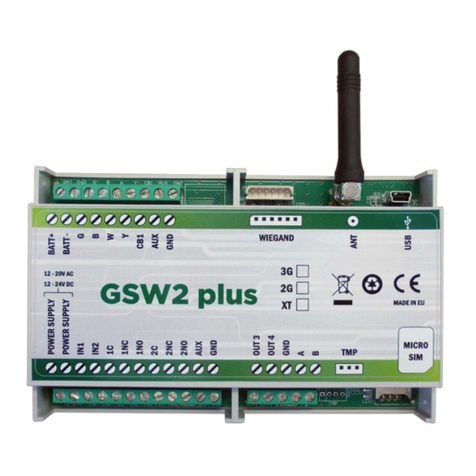
Page 3
9.20 RECEIVE SPIN ACCESS CODES PARAMETERS (PSPIN)...........................................................................................38
9.21 RECEIVE INTERCOM BUTTON 1 PARAMATERS (PDEA) ........................................................................................39
9.22 RECEIVE INTERCOM BUTTON 2 PARAMATERS (PDEB).........................................................................................39
9.23 STATE OF THE CREDIT FOR THE PREPAID CARD...................................................................................................39
9.24 STATE OF THE OUTPUTS (PORC) ................................................................................................................................39
9.25 MANUAL GSM MODULE RETARD (MRES)................................................................................................................39
9.26 RECEIVE STATUS OF INPUTS (INS).............................................................................................................................39
9.27 RECEIVE GSW2 PLUS LOG............................................................................................................................................39
9.28 RECEIVE WIEGAND PARAMETERS ............................................................................................................................39
10 CHANGING PARAMETERS USING THE SMS COMMAND...............................................................40
11 DEFAULT SETTINGS ON GSW2 PLUS...................................................................................................41
12 PARAMETERS PRINT-OUT COMMANDS.............................................................................................44
13 TECHNICAL SPECIFICATIONS ..............................................................................................................45
14 CONTACTS...................................................................................................................................................46
Figures
Figure 1: GSW2 PLUS Connection diagram..............................................................................................................................10
Figure 2: Input Connection diagram...........................................................................................................................................12
Figure 3: Output Connection diagram ........................................................................................................................................16
Figure 4: GSW2 PLUS Intercom connection diagram ...............................................................................................................26
Figure 5: GSW2 PLUS Intercom connection diagram - details..................................................................................................29
Tables
Table 1: IN, ID and DD parameters............................................................................................................................................13
Table 2: IN, ID, DD parameters example...................................................................................................................................13
Table 3: Remote alarm reporting parameters..............................................................................................................................14
Table 4: Remote alarm reporting parameters example ...............................................................................................................15
Table 5: Output management parameters ...................................................................................................................................17
Table 6: Output management parameters example.....................................................................................................................17
Table 7: SL parameter ................................................................................................................................................................18
Table 8: SL parameter example..................................................................................................................................................18
Table 9: Prepaid card validity parameters...................................................................................................................................20
Table 10: Credit example............................................................................................................................................................20
Table 11: Set-up parameters .......................................................................................................................................................24
Table 12: Set-up parameters example.........................................................................................................................................24
Table 13: Message parameters....................................................................................................................................................25
Table 14: Message parameters example .....................................................................................................................................25
Table 15: Intercom parameters. ..................................................................................................................................................28
Table 16: Intercom parameters example.....................................................................................................................................28
Table 17: DTMF control example ..............................................................................................................................................30
Table 18: CLIP parameters.........................................................................................................................................................31
Table 19: CLIP parameters example...........................................................................................................................................31
Table 20: Entering PIN code parameters....................................................................................................................................32
Table 21: Entering PIN access code example.............................................................................................................................32
Table 22: Entering SPIN access code parameters.......................................................................................................................33
Table 23: Entering SPIN access codes example.........................................................................................................................33
Table 24: LOG parameters .........................................................................................................................................................34
Table 25: LOG parameters example...........................................................................................................................................34
Table 26: SMS commands..........................................................................................................................................................35
Table 27: SMS commands example. ..........................................................................................................................................35
Table 28: GSW2 PLUS default settings .....................................................................................................................................43
Table 29: GSW2 PLUS parameters print out commands ...........................................................................................................44





























